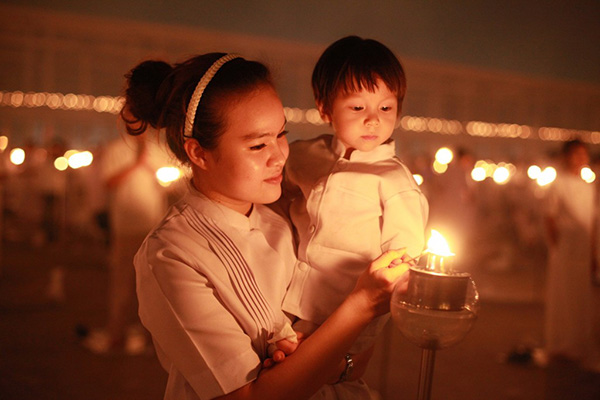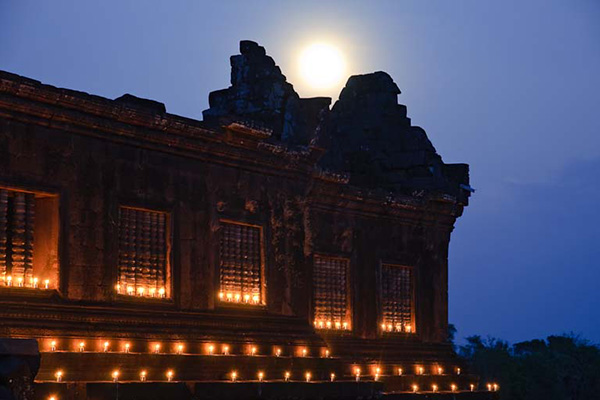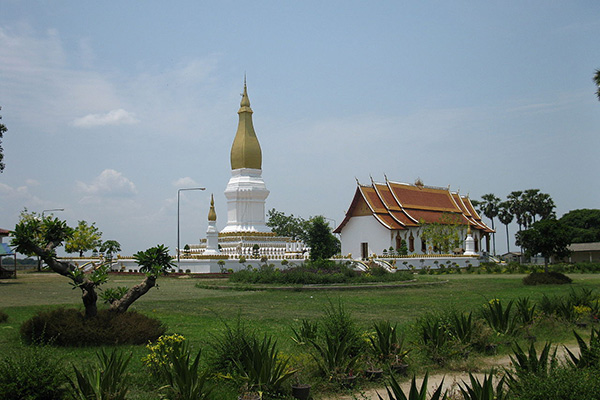If Laos is considered as a country of festivals and celebrations, February can be said to be the month of festivals as it encompasses more festivals than other months throughout the year. There are up to 4 festivals fall in February, which are Magha Puja, the Sikhotabong, the Wat Phu and the Elephant festival. All of them have their own special appeal featuring diversely traditional cultures of Laotians.
Magha Puja Festival
- Time: The full moon day in February (The day of the celebration may change from one year to the following)
- Duration: 1 day
- Location: Throughout Laos
- Meaning: The festival is organized to commemorate the original teachings of Lord Buddha for 1250 enlightened monks from different regions.

The festival is marked by grand parades of candle-bearing worshippers circling their local temples, merit making, and much religious music and chanting.
Wat Phu Festival
- Time: The full moon day in February (Coincide with Magha Puja)
- Duration: 3 days and 3 nights or 7 days and 7 nights
- Location: The pre-Angkorian Wat Phu site in Champassak province
- Meaning: The festival is held to commemorate all those who have contributed to Wat Phou Champasack, the most famous Hindu temple complex built in Laos under the Khmer Empire.

During this festival, the believers coming from different areas attend the ceremony; some of them even come from Thailand and Cambodia; it is also the opportunity for surrounding plain and mountain populations to meet each other, maintaining these relations since time put off. Processions, recitals, and chants take place on this festival. Boats racing, game "catch-ducks"; volleyball and petanque competitions are also held.
The Sikhotabong Festival
- Time: Between February 5th and February 8th
- Duration: 4 days
- Location: The Sikhotabong Stupa in the province of Khammouant
- Meaning: The festival is held for locals to pay homage to the Sikhotabong Stupa.

The Sikhotabong Stupa is a religious site and one of the most sacred places in Laos. It was originally erected by the Sikhottabong Empire to keep relics of Lord Buddha erected between 9th and 10th century. However, the Khmer Empire renovated the stupa in Hindu style soon after. During 1950s, it was restored to the present form by the Lane Xang Kingdom’s King Phothisarat and King Saysethathirath.
Elephant Festival
- Time: Mid-February
- Duration: 2 days
- Location: Xayaboury province
- Meaning: The festival is held to grab the public's attention to the endangered Asian elephants, meanwhile, celebrating the ancestral tradition of elephant domestication.

Annually, more than 50 elephants and their mahouts from a wide range of different areas gather to demonstrate working techniques and pay tribute to the national symbol of “The Land of Million Elephants”. After an opening ceremony, a procession of elephants enters the host village through a bamboo arch. The elephants bathe and are blessed by monks, with participants making merit in a baci ceremony, before with the election of the “Elephant of the Year”. Then the entertainment begins: pachyderm performances, musical concerts, outdoor films, dance shows, and fireworks displays in a carnival atmosphere that includes elephant rides and a “Fun Fair”.
February in Laos is a vibrant and exciting time filled with captivating festivals that are sure to delight and inspire tourists. By joining a Laos tour in February, you can witness the lively water fights, partake in traditional rituals, and experience the true spirit of Lao culture. These festivals offer a unique opportunity to engage with locals, learn about ancient traditions, and create unforgettable memories. Don't miss the chance to be a part of the festive atmosphere that fills Laos in January and make your journey a truly immersive and enriching experience.
